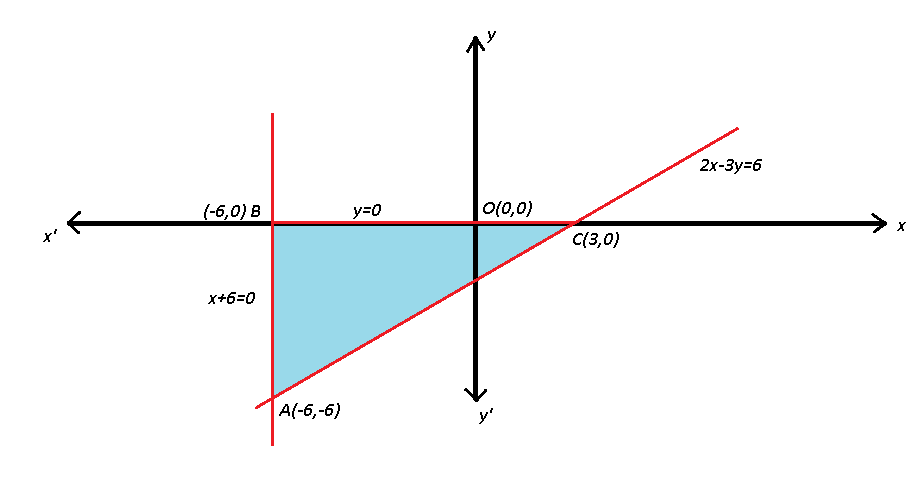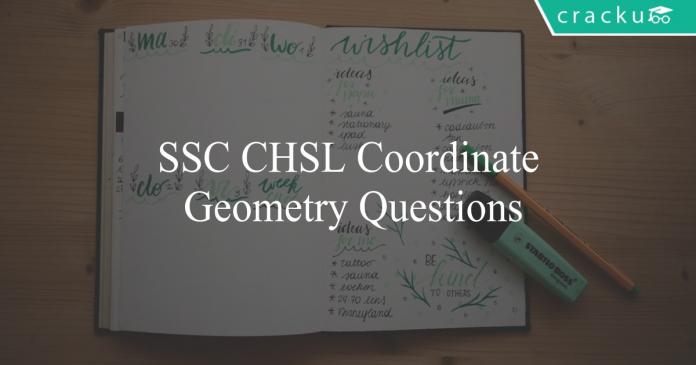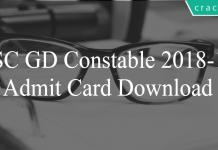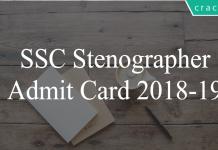SSC CHSL Coordinate Geometry Questions
SSC CHSL Expected GK Questions download PDF based on previous year question paper of SSC exams. 20 Very important Expected GK questions for SSC CHSL Exam.
Download SSC CHSL Coordinate Geometry Questions
Take a free mock test for SSC CHSL
Download SSC CHSL Previous Papers
Question 1: Find the coordinates of the point which divides the line joining (3,4) and (-1,8) internally in the ratio 1:3.
a) (5 , 2)
b) (4 , 2.6)
c) (2 , 5)
d) (4 , 2)
Question 2: Find the coordinates of the point which divides the line joining the points (4,2) and (4,6) internally in the ratio 2:3.
a) (4 , 3.6)
b) (3 , 4)
c) (3.6 , 4.2)
d) (2.8 , 3.6)
Question 3: Find the equation of the line which passes through the midpoint of (2,3) and (-4,1) having slope=-2.
a) -2x+y=0
b) 2x+y=0
c) 2x+2y-2=0
d) 2x-2y+2=0
Question 4: Find the equation of the line which is parallel to the line 4x+3y-7=0 and passes through the point (4,-3).
a) 3x-4y=0
b) 4x+3y-7=0
c) 4x+3y-10=0
d) 3x+4y=0
Question 5: Find the equation of the line which is parallel to the line 8x+7y-3=0 and passes through the point (3,-2).
a) 5x+7y-1=0
b) 8x+7y+10=0
c) 8x+7y-10=0
d) 5x+7y+1=0
SSC CHSL Study Material (FREE Tests)
Question 6: What is the equation of the line which is perpendicular to 2x+3y-5=0 and passing through the point of intersection of the lines x+2y-7=0 and 5x-3y+4=0
a) 3x+2y-3=0
b) 3x-2y+3=0
c) 3x-2y-3=0
d) 3x+2y+3=0
Question 7: What is the area of the triangle formed with coordinate axis by the line having slope equal to the line x+2y-5=0 and passing through (2,1) ?
a) 4
b) 6
c) 7
d) 3
Question 8: What is the area of the triangle formed with coordinate axis by the line having slope equal to the line 2x+3y-5=0 and passing through (1,2) ?
a) 14/3
b) 16/3
c) 17/3
d) 13/3
Question 9: What is the equation of a line which passes through the point of intersection of lines A:x-3y=7 and B:2x+y=-7 and the required line is also perpendicular to line x+4y=10 ?
a) 4x-y+4=0
b) 4x-y+5=0
c) 4x-3y-1=0
d) x-4y-10=0
Question 10: Equation of one of the diagonals of a rhombus is 2x+3y=10. what is the equation of the other diagonal passing through the point (1,3) ?
a) $3x+2y-9=0$
b) $6x-4y+5=0$
c) $3x-2y+3=0$
d) $2x+3y-11=0$
Question 11: The straight line y=3x must pass through the point:
a) (0,1)
b) (0,0)
c) (2,0)
d) (1,2)
Question 12: A is a point on the x-axis with abscissa – 8 and B is the pint on the y-axis with ordinate 15. The length of AB is
a) 19 units
b) 21 units
c) 17 units
d) 23 units
Question 13: What is the reflection of the point (-5, -2) in the line y = 1?
a) (-5, 1)
b) (-5, 4)
c) (-5, 0)
d) (-5, 5)
Question 14: If (1, 3) is the centroid of triangle ABC, with co-ordinates A(1, 6), B(3 , a) & C(b, 1), what is the value of a + b?
a) 5
b) 1
c) 6
d) 4
Question 15: What is the reflection of the point ( 6, -3) about the line y = -3?
a) (6, 3)
b) (6, 0)
c) (6, -6)
d) (6, -3)
FREE SSC MATERIAL – 18000 FREE QUESTIONS
Question 16: Find the area (in sq units) enclosed by y = 0, x+6=0 and 2x-3y=6.
a) 9
b) 16
c) 20
d) 27
Question 17: What is the area of the triangle made by line 3x+4y = 24 with the coordinate axes?
a) 6 square units
b) 12 square units
c) 24 square units
d) 48 square units
Question 18: A cube is cut into 8 equal smaller cubes.The percentage change in the surface area is
a) 80%
b) 50%
c) 150%
d) 100%
Question 19: Find the centroid of the triangle formed by the vertices, P(-4,-2) Q(-3, -5) and R(1, 1) ?
a) (2, -2)
b) (-2, 2)
c) (-2,-2)
d) (2, 2)
Question 20: Which of the following represents hyperbola ?
a) $x^2+y^2 = a^2$
b) $\frac{x^2}{a^2}+\frac{y^2}{b^2} = 1$
c) $\frac{x^2}{a^2}-\frac{y^2}{b^2} = 1$
d) None of the above
DOWNLOAD APP TO ACESSES DIRECTLY ON MOBILE
Answers & Solutions:
1) Answer (C)
Here, $x_1 = 3, x_2 = -1$
$y_1 = 4$ and $y_2 = 8$
m = 1 and n = 3
Required coordinates of the point = $(\dfrac{mx_2+nx_1}{m+n} , \dfrac{my_2+ny_1}{m+n})$
$= (\dfrac{-1+9}{4} , \dfrac{8+12}{4})$
$= (\dfrac{8}{4} , \dfrac{20}{4})$
$= (2 , 5)$
2) Answer (A)
Here, $x_1 = 4, x_2 = 4$
$y_1 = 2$ and $y_2 = 6$
m = 2 and n = 3
Required coordinates of the point = $(\dfrac{mx_2+nx_1}{m+n} , \dfrac{my_2+ny_1}{m+n})$
$= (\dfrac{8+12}{5} , \dfrac{12+6}{5})$
$= (\dfrac{20}{5} , \dfrac{18}{5})$
$= (4 , 3.6)$
3) Answer (B)
midpoint of (2,3) and (-4,1) is ((2-4)/2,(3+1)/2)
=((-2/2),(4/2))
=(-1,2)
Given that line has a slope of -2
Requires equation is (-2)(x+1)=y-2
-2x-2=y-2
-2x-y=0
2x+y=0
4) Answer (B)
slope of the line ax+by+c=0 is -a/b
Slope of the line 4x+3y-7=0 is -4/3
Two parallel lines has same slope
(-4/3)(x-4)=(y+3)
-4x+16=3y+9
4x+3y-7=0
5) Answer (C)
slope of the line ax+by+c=0 is -a/b
Slope of the line 8x+7y-3=0 is -8/7
Two parallel lines has same slope
(-8/7)(x-3)=(y+2)
-8x+24=7y+14
8x+7y-10=0
6) Answer (B)
Given line 2x+3y-5=0
y=-(2/3)x+5/3
slope=-2/3
Product of slopes of 2 perpendicular lines=-1
(-2/3) *m =-1
m=3/2
Given lines are x+2y-7=0 and 5x-3y+4=0
5x+10y-35=0
5x-3y+4=0
13y=39
y=3
x=1
Required equation is (3/2)(x-1)=y-3
3x-3=2y-6
3x-2y+3=0
7) Answer (A)
x+2y-5=0
y=-x/2 +5/2
It is in the form of y=mx+c
m=-1/2
Slope of two parallel lines is equal.
Required equation of the line is
-(1/2)((x-2)=y-1
-x+2=2y-2
x+2y-4=0
Expressing equation of line in the form of (x/a)+(y/b)=1
Area of triangle is (1/2)ab
x/(4)+y/(2)=1
Area of the triangle=(1/2)*4*2
=4
8) Answer (B)
2x+3y-5=0
y=-2x/3 +5/3
It is in the form of y=mx+c
m=-2/3
Slope of two parallel lines is equal.
Required equation of the line is
-(2/3)(x-1)=y-2
-2x+2=3y-6
2x+3y-8=0
Expressing equation of line in the form of (x/a)+(y/b)=1
Area of triangle is (1/2)ab
x/(4)+y/(8/3)=1
Area of the triangle=(1/2)*4*8/3
=16/3
9) Answer (B)
The point of intersection of the lines A and B is (-2,-3)
the line is perpendicular to x+4y=10
Slope of x+4y=10 is ($\frac{-1}{4}$)
$\frac{-1}{4}\times s $=-1
s=4
Equation of line is 4(x+2)=y+3
4x+8=y+3
4x-y+5=0
10) Answer (C)
Diagonals of a rhombus are perpendicular to each other.
Lines perpendicular to each other have the product of their slopes = -1
Slope of the line 2x+3y-10=0 is $-(\frac{a}{b})$
Slope = $\frac{-2}{3}$
Then slope of the other line is $ \frac{3}{2}$.
$\therefore$ required equation is $\frac{3}{2}(x-1)=(y-3)$
$3x-3=2y-6$
$ 3x-2y+3=0$
11) Answer (B)
Equation of line = $y=3x$
(A) : (0,1)
=> L.H.S. = $1\neq$ R.H.S. = $3(0)=0$
(B) : (0,0)
=> L.H.S. = $0=$ R.H.S. = $3(0)=0$
=> Ans – (B)
12) Answer (C)

Now, OA = 8 units and OB = 15 units
=> $(AB)^2=(OA)^2+(OB)^2$
=> $(AB)^2=(8)^2+(15)^2$
=> $(AB)^2=64+225=289$
=> $AB=\sqrt{289}=17$ units
=> Ans – (C)
13) Answer (B)
We can see that (-5, -2) is 3 units away from y = 1
X coordinate of the point will remain unchanged while y axis will change
$\Rightarrow$ $1 = \frac{-2 + b}{2}$
$\Rightarrow$ $2 = -2 + b$
$\Rightarrow$ $b = 4$
Alternatively from graph we can see the reflection of point as well. (Answer :B)

14) Answer (B)
Centroid = $(\frac{x_{1}+x_{2}+x_{3}}{3} , \frac{y_{1}+y_{2}+y_{3}}{3})$
$(1, 3)$ = $(\frac{1 + 3 + b}{3} , \frac{6 + a + 1}{3})$
$\Rightarrow$ $1 = \frac{1 + 3 + b}{3}$
$\Rightarrow$ $b + 4 = 3$
$\Rightarrow$ $b = -1$
Also, we know that $3 = \frac{6 + a + 1}{3}$
$\Rightarrow$ $a + 7 = 9$
$\Rightarrow$ $a = 2$
Therefore, a+b = 2 -1 = 1.
Hence, option B is the right answer.
15) Answer (D)
Since the given point (6, -3) lies on the line y = -3 itself, the point and its reflection will coincide.
Therefore, the reflection of point = (6, -3).
Hence, option D is the right answer.
16) Answer (D)
The graph represented by the lines : $y=0$, $x+6=0$ and $2x-3y=6$ is

Now, area of $\triangle$ ABC with base $BC=9$ units and height $AB=6$ units
= $\frac{1}{2}bh$
= $\frac{1}{2}\times9\times6=27$ sq. units
=> Ans – (D)
17) Answer (C)
The given line will cut the x-axis at a point where the y co-ordinate will be equal to zero.
$\Rightarrow$ 3x + 4*0 = 24.
$\Rightarrow$ x = 8.
So, the point of intersection on the x axis will be (8, 0).
Similarly, the line will cut y-axis at a point where the x co-ordinate will be equal to zero.
$\Rightarrow$ 3*0 + 4y = 24.
$\Rightarrow$ y = 6.
So, the point of interaction on the y axis will be (0, 6)

We can see that $\triangleOAB$ is right-angled at O.
So, the area of $\triangleOAB$ = $\frac{1}{2} * OA * OB$
= $\frac{1}{2} * 6 * 8$
= 24 sq units.
Therefore, option C is the right answer.
18) Answer (D)
Let us assume the side of the original cube to be 2a units.
=> The surface area of the bigger cube = $6*(2a)^{2} = 24(a)^{2}$
When we cut the original cube to get 8 smaller cubes, each side will become half of its original length.
So, the side of smaller cube will be 2a/2 = a units in length.
Surface area of 1 smaller cube = $6*(a)^{2} = 6(a)^{2}$
Total surface area of 8 cubes combined = $8 * 6(a)^{2} = 48(a)^{2}$
So, the percentage change in the surface area = $\frac{48(a)^{2} – 24(a)^{2}}{24(a)^{2}} \times 100$ = 100 %.
Therefore, option D is the right answer.
19) Answer (C)
Centroid = ($\frac{x_1+x_2+x_3}{3}, \frac{y_1+y_2+y_3}{3}$) = ($\frac{-4-3+1}{3}, \frac{-2-5+1}{3}$) = (-2, -2)
So the answer is option C.
20) Answer (C)
Option A & B, represent Ellipse. ($\because$ general form of Ellipse is $\frac{x^2}{a^2}+\frac{y^2}{b^2} = 1$)
Option C represents Hyperbola. ($\because$ general form of Hyperbola is $\frac{x^2}{a^2}-\frac{y^2}{b^2} = 1$)
So the answer is option C.





